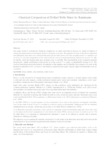Por favor, use este identificador para citar o enlazar este ítem:
http://www.alice.cnptia.embrapa.br/alice/handle/doc/1061081Registro completo de metadatos
| Campo DC | Valor | Lengua/Idioma |
|---|---|---|
| dc.contributor.author | MANERA, D. B. | pt_BR |
| dc.contributor.author | VOLTOLINI, T. V. | pt_BR |
| dc.contributor.author | MENZES, D. R. | pt_BR |
| dc.contributor.author | ARAUJO, G. G. L. de | pt_BR |
| dc.date.accessioned | 2017-01-18T23:03:10Z | - |
| dc.date.available | 2017-01-18T23:03:10Z | - |
| dc.date.created | 2017-01-18 | pt_BR |
| dc.date.issued | 2016 | pt_BR |
| dc.identifier.citation | Journal of Agricultural Science, v. 8, n. 12, p. 127-137, 2016. | pt_BR |
| dc.identifier.issn | 1916-9760 | pt_BR |
| dc.identifier.uri | http://www.alice.cnptia.embrapa.br/alice/handle/doc/1061081 | pt_BR |
| dc.description | This study aimed to evaluate the chemical composition of water wells and to discuss the results in relation to nutritional requirements and tolerance limits of domestic ruminants. Ten samples of water wells (three replicates) from Brazilian semi-arid were collected and analyzed for their macro and trace minerals levels. A variation was found in the mineral composition of the waters and the macro minerals presenting highest levels were Cl, Mg, Ca and Na, while the predominant trace minerals were Fe and Mn. The concentration of the examined minerals can provide a small contribution to the animal as in the case of P or supply a considerable amount as Cl. The levels of total dissolved solids found in the majority of the samples can be tolerable for ruminants. In some of the samples the resence of Pb, Cd and Cr was found in concentrations higher than the upper recommended limit for ruminants. | pt_BR |
| dc.language.iso | eng | eng |
| dc.rights | openAccess | eng |
| dc.subject | Poço de água | pt_BR |
| dc.subject | Minerais traços | pt_BR |
| dc.subject | Fonte de água | pt_BR |
| dc.subject | Composição mineral da água | pt_BR |
| dc.subject | Consumo animal | pt_BR |
| dc.subject | Ruminantes | pt_BR |
| dc.title | Chemical composition of drilled wells water for ruminants. | pt_BR |
| dc.type | Artigo de periódico | pt_BR |
| dc.date.updated | 2017-01-18T23:03:10Z | pt_BR |
| dc.subject.thesagro | Produção animal | pt_BR |
| dc.subject.thesagro | Água | pt_BR |
| dc.subject.thesagro | Contaminação | pt_BR |
| dc.subject.thesagro | Metal pesado | pt_BR |
| dc.subject.thesagro | Composição Química | pt_BR |
| dc.subject.nalthesaurus | Animal production | pt_BR |
| riaa.ainfo.id | 1061081 | pt_BR |
| riaa.ainfo.lastupdate | 2017-01-18 | pt_BR |
| dc.identifier.doi | 10.5539/jas.v8n12p127 | pt_BR |
| dc.contributor.institution | DANIEL BOMFIM MANERA, UNIVASF; TADEU VINHAS VOLTOLINI, CPATSA; DANIEL RIBEIRO MENEZES, UNIVASF; GHERMAN GARCIA LEAL DE ARAUJO, CPATSA. | pt_BR |
| Aparece en las colecciones: | Artigo em periódico indexado (CPATSA)  | |
Ficheros en este ítem:
| Fichero | Descripción | Tamaño | Formato | |
|---|---|---|---|---|
| Tadeu.pdf | 181.07 kB | Adobe PDF |  Visualizar/Abrir |









